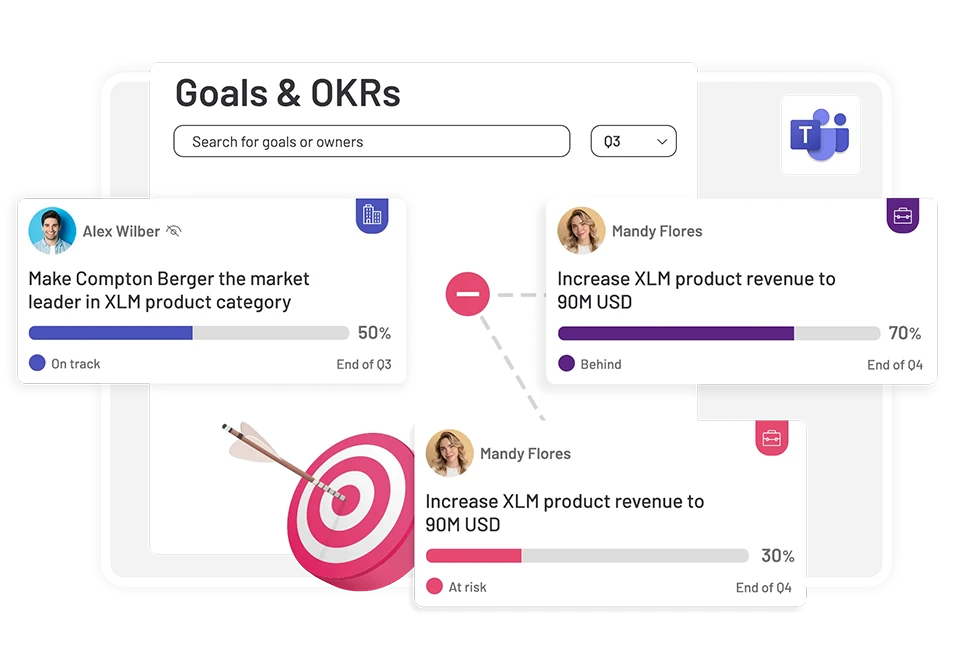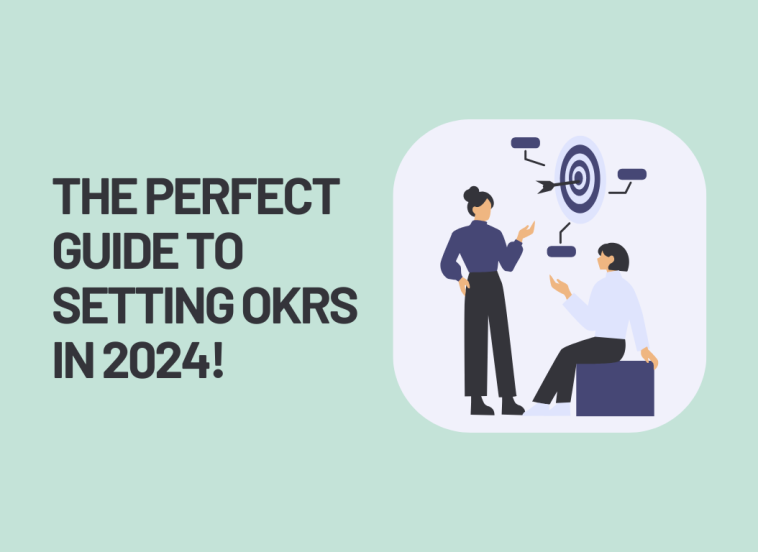With more and more OKR examples and organizations providing the world with incredibly helpful sample OKR frameworks coming out of the woodwork each passing year, we here at Teamflect made a bold prediction:
OKR Goal Setting isn’t going anywhere in 2023!
What? No rewards for the “hot take of the year”? Oh well. We’ll surely win that with our article on the benefits of employee engagement! Or one of our actually controversial pieces where we discussed how employee monitoring software actually has an adverse effect on productivity.
Returning to the subject matter at hand after this lengthy detour, we do believe in just how beneficial OKRs are as a goal-setting and performance-management practice.
We’ve published multiple OKR guides on the matter but in this article, we really want to focus on some OKR best practices for 2023, and some OKR examples you can find inspiration in.
Whether you are already using OKRs or switching from KPIs to OKRs, we believe there is something for you in this guide. Enjoy!
Table of Contents
Best Practices for 2023
As we move into 2023, there are a few key strategies that can help ensure your OKRs are effective and driving the results you want.
1. Align your goals with your OKRs.
New year, new you, new goals! One of the most important considerations is alignment (and not the physio-therapy kind). OKRs should be aligned with your organization’s overall mission and goals, as well as with the objectives and key results of other teams and departments. This alignment ensures that everyone is working towards the same overarching goals and that resources are being used efficiently.
2. Cascading OKRs is a great, digestible practice.
Another important strategy is cascading OKRs. This means breaking down the objectives and key results for the entire organization into smaller, more specific OKRs for individual teams and individuals. This helps ensure that everyone understands their role in achieving the company’s goals and how their work contributes to the bigger picture.
3. Stay on top of your OKRs with the right tools.

A good OKR governance structure is also important for ensuring that the OKRs are being implemented and tracked effectively. This includes clearly defined roles and responsibilities, regular progress check-ins, and a system for adjusting OKRs as needed.
Performance management and performance reviews should also be linked with OKRs. OKRs are a way of measuring the performance of an employee and hence should be aligned with the performance management system. This will provide a clear picture of the employee’s performance and their contribution to the organization
In addition, to effectively track and monitor progress, there are also tools and software available that can help. From simple spreadsheet OKR templates to more advanced and objectively stronger OKR software that includes real-time reporting and analytics, there is a wide range of options available.
If you want our opinion, we believe that you should definitely consider investing in OKR software. We have made a list in the past of some of the 6 best OKR software you can find in this matter. A great example of one of the options on that list would be Teamflect.
For organizations using Microsoft Teams in their day-to-day operations, there is no better OKR tool than Teamflect. Sporting an incredible integration with all Microsoft Office tools, Teamflect should be able to cover all your OKR needs and then some!
OKR Examples: Samples you can use as your okr framework
The four OKR examples below are OKR examples from multiple different fields. Ranging from tech, which gave the world its introduction to OKR examples, to education, a field that isn’t the most heavily populated when it comes to OKR examples.
- A retail company set an objective to “Increase online sales by 20% in the next quarter.” One of the key results they established to measure the success of this objective was to “Improve the mobile shopping experience by launching a new app.” By focusing on this specific key result, the company was able to drive online sales and meet its objective.
- A healthcare organization aimed to “Reduce the number of readmissions within 30 days by 15%.” To accomplish this objective, they established a key result of “Implementing a comprehensive discharge planning process.” This key result helped to ensure that patients received the necessary support and follow-up care after they were discharged from the hospital, which helped to reduce the number of readmissions.
- A tech startup had an objective to “Acquire 100 new enterprise clients within the next year.” One of the key results established to achieve this objective was “Develop and launch a targeted marketing campaign.” The campaign helped the company reach its target market, resulting in a significant increase in the number of enterprise clients.
- A school set an objective to “improve student engagement and performance by 20% in the next academic year.” One of the key results they established to measure the success of this objective was to “implement a blended learning approach.” By combining traditional classroom instruction with online resources, the school was able to increase student engagement, and as a result, student performance improved and they achieved their objective.
These good OKR examples illustrate how OKRs can be used to drive specific, measurable results in different industries. It’s also important to note that these examples align with the strategy and mission of the organization and how they impact the overall performance.
We really have to keep in mind the fact that these okr examples for growth are exactly what they are. They are examples. It’s not necessary that all organizations have to have the same OKRs. Each organization has its unique strategy, mission, and goals. OKRs should be set accordingly.
OKR examples for sales teams
Are OKRs good for sales teams? The answer is a resounding yes. No team needs a clear set of objectives and key results more than sales. Clear objectives and accountability are two integral aspects of managing a sales team. That is why OKRs are great for sales teams. Here are some OKR examples for sales teams.
Objective: Increase Revenue Growth
Key Result 1: Achieve 20% increase in total sales revenue compared to the previous quarter by the end of the current fiscal year.
Key Result 2: Increase average deal size by 15% by implementing upselling and cross-selling strategies within the next six months.
Key Result 3: Expand the customer base by acquiring 50 new high-value clients within the next quarter through targeted marketing and sales campaigns.
Objective: Improve Sales Team Efficiency
Key Result 1: Reduce the average sales cycle length by 20% by implementing streamlined processes and effective lead nurturing techniques within the next two quarters.
Key Result 2: Increase the number of qualified leads by 30% by optimizing lead generation channels and sales prospecting strategies within the current fiscal year.
Key Result 3: Improve the win rate by 10% by providing sales training and conducting regular performance evaluations for the sales team within the next six months.
Objective: Enhance Customer Satisfaction and Retention
Key Result 1: Achieve a customer satisfaction score of 90% or higher based on post-sales surveys by the end of the current quarter.
Key Result 2: Reduce customer churn rate by 15% by identifying and addressing customer pain points through enhanced support and personalized follow-ups within the next four months.
Key Result 3: Increase the number of customer referrals by 25% through a customer referral program and exceptional customer service within the current fiscal year.
OKR examples for project managers
Objectives and key results are incredible tools, fit for the arsenal of any project manager out there. OKRs help leaders divide projects into easily achievable, digestible pieces. When picking OKR examples for project managers, you can either pick OKRs for improving project efficiency or turn each moving part of the project into objectives of their own. Either way, you can pick one of the OKR examples for project managers below or use them as objectives and key result examples to create your own.
Objective: Improve Project Delivery Efficiency
Key Result 1: Reduce project completion time by 20% by optimizing project planning, resource allocation, and task prioritization within the next three months.
Key Result 2: Increase on-time project delivery rate to 95% by identifying and addressing bottlenecks, risks, and dependencies during project execution within the current quarter.
Key Result 3: Implement project management tools and methodologies to achieve a 15% improvement in team productivity within the next six months.
Objective: Enhance Project Quality and Client Satisfaction
Key Result 1: Achieve a client satisfaction score of 9 out of 10 on post-project feedback surveys for all projects completed this year.
Key Result 2: Reduce the number of project-related issues and defects by 25% through rigorous quality control measures and continuous process improvement within the next four months.
Key Result 3: Conduct regular project reviews and lessons learned sessions to ensure a 10% increase in the number of successful project deliveries by the end of the current fiscal year.
Objective: Foster Effective Team Collaboration and Communication
Key Result 1: Implement team collaboration tools and establish communication protocols to increase cross-functional collaboration and knowledge sharing by 30% within the next three months.
Key Result 2: Organize monthly team-building activities and training sessions to enhance team cohesion and improve communication skills, resulting in a 20% increase in team satisfaction scores by the end of the current quarter.
Key Result 3: Foster a culture of open feedback and continuous improvement by conducting bi-monthly feedback sessions and tracking a 15% increase in employee engagement scores within the next six months.
OKR examples for operations
OKRs are incredibly useful for operations departments. Each step for an operations team can be turned into an objective of its own with subsequent key results to match them. You will find that OKR examples for operations are often based on making momentary or long-lasting changes in organizations, as well as solving problems as they arise. So here are some operations OKRs.
Objective: Build Cross-Functional Teams
Key Result 1: Form three cross-functional teams, each comprising members from different departments, to collaborate on high-priority projects by the end of the current quarter.
Key Result 2: Conduct regular team-building workshops and training sessions to enhance collaboration and communication among cross-functional team members, resulting in a 15% increase in team productivity within the next six months.
Key Result 3: Measure the success of cross-functional teams by tracking the number of successful projects delivered and aiming for a 25% improvement in project success rate within the current fiscal year.
Objective: Implement Hybrid or Remote Work Model
Key Result 1: Develop and communicate a comprehensive hybrid work policy that outlines guidelines, expectations, and technology requirements for remote and in-office employees by the end of the current quarter.
Key Result 2: Ensure that all necessary infrastructure and tools are in place to support seamless remote work, resulting in 90% employee satisfaction with remote work arrangements within the next four months.
Key Result 3: Conduct regular surveys and performance evaluations to assess the effectiveness of the hybrid work model and aim for a 20% increase in overall employee productivity within the current fiscal year.
How to create effective OKRs in 2023:
Setting Objectives
The first step is to identify the company’s overall mission and goals. These should be the overarching targets that the organization is working towards, and they should be specific, measurable, and attainable.
A goal for a technology company could be to “Increase revenue by 15% in the next quarter” or for a non-profit organization “Reduce the number of homeless in the city by 20% in the next year”.
Once the overall goals have been established, it’s time to break them down into specific, measurable, attainable, relevant, and time-bound objectives. These objectives should align with the overall goals and be specific enough that they can be effectively tracked and measured.
An objective for a technology company might be “Improve customer retention by launching a new loyalty program” or for a non-profit organization “Provide housing for 100 homeless individuals within the next 6 months”.
It’s also essential to assign ownership for each objective. This means designating a specific team or individual who will be responsible for achieving the objective and ensuring that it is completed on time. This helps to ensure that everyone knows their role in achieving the objectives and is working towards the same goal.
When setting objectives, it’s important to keep in mind that they should be challenging but also achievable. It’s essential to find the right balance between being ambitious and realistic. It’s also important to be specific, measurable and time-bound, which will help make it clear when the objective has been achieved or not.
Establishing Key Results

Once you’ve set your objectives, the next step is to establish the key results that will help you measure the success of those objectives. Key results are specific, measurable targets that help you determine whether or not you’ve achieved an objective. They are also an important way to track progress towards your goals. Below you will find some key result examples.
To establish key results, it’s important to determine the metrics that will be used to measure success. These metrics should be relevant to the objective they are measuring and should be specific and measurable.
If your objective is to increase online sales by 20%, a relevant key result would be to track the number of online sales in a given period. Another key result could be the website’s conversion rate, which would be an indicator of how many website visitors turned into customers.
It’s also essential to set realistic and specific targets for each key result. These targets should be challenging, but achievable, and should align with the overall objective.
If you want to increase online sales by 20%, you should set a specific target of a certain number of sales within a certain timeframe.
When it comes to establishing key results, it’s also important to make sure they are linked to the objective they are measuring. This way, you can track progress and see how close you are to achieving your objectives.
Implementation

Now that you’ve set your objectives and established your key results, it’s time to implement your OKRs. This is where the rubber hits the road and the plans come to life. But fear not, with good communication, clear roles, and tools for tracking progress, you can put your OKRs into action and achieve your goals.
The first step in implementation is to communicate your OKRs to the entire organization. This means clearly and effectively communicating the objectives, key results, and roles and responsibilities to everyone who needs to know. Also, make sure to explain the “why” behind the OKRs, which will help everyone understand the big picture and the purpose of their work.
Ensuring that everyone understands their role in achieving the objectives and key results is also essential. This means identifying what needs to be done, by whom, and by when. This will help keep everyone accountable and on track to achieve the objectives.
Regularly tracking progress and adjusting OKRs as needed is also important. Set up regular check-ins and progress reviews. And, remember, if something isn’t working, don’t be afraid to change it. One of the great things about OKRs is that they are flexible and can be adjusted as needed.
Having tools in place to help you track and monitor progress will save you a lot of headaches. With the right software or templates, you can easily monitor progress, make adjustments, and keep everyone informed of the status of your objectives.




